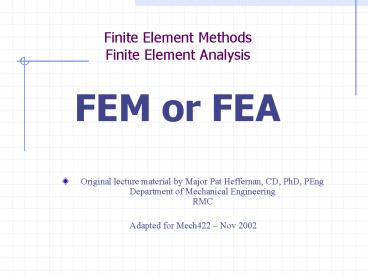Finite Element Methods Finite Element Analysis - PowerPoint PPT Presentation
1 / 17
Title: Finite Element Methods Finite Element Analysis
1
Finite Element MethodsFinite Element Analysis
FEM or FEA
- Original lecture material by Major Pat Heffernan,
CD, PhD, PEngDepartment of Mechanical
EngineeringRMC - Adapted for Mech422 Nov 2002
2
References
- Cook, R.D., Malkus, D.S., Plesha, R.E., and Witt,
R.J., 2002. Concepts and Applications of Finite
Element Analysis, 4th Ed, Wiley, NY, USA. - Huebner K.H., et al., 2001. The Finite Element
Method For Engineers, 4th Ed, Wiley, NY, USA.
3
Introduction
- What is the Finite Element Method (FEM) and how
does it relate to CAD/CAM? - What is CAD/CAM?
- Design
- Manufacturing
- Why use CAD/CAM?
- Design Manufacture New Products
- Less Time
- Lower Cost
- Enhance Overall Productivity
4
MCAE
Mechanical Computer Aided Engineering
- Allows for concurrent engineering
- Analysis/Manufacturing Processes/Jigs can be done
in parallel - More design alternatives can be explored
- Reduces life-cycle costs
- Founded on Solid Modelling (not 2-D drawings)
- Solid Model used for
- Mass Property calculations
- Interference Studies
- Stress Analysis
- Manufacturing Planning
- If necessary, creation of conventional 2D drawings
5
Product Cycle
Design and Manufacturing
with CAD/CAM overlaid
FEM
6
Finite Element Method
A numerical analysis technique for obtaining
approximate solutions to engineering problems.
- Discrete elements approximating a continuum
- Used when the geometry is too complex for an
analytical solution - Continuum is divided into a finite number of
elements - Each element represents a portion of the
structure - Compatibility must be maintained at inter-element
boundaries - Equations are generated to represent the system
and a numerical solution is determined - Accuracy is largely dependent on mesh size
7
Finite Element Method (contd)
- 2D or 3D Elements
- 2D or 3D Problems
- Ideal for complex problems that are difficult to
solve analytically - Computation time is a large concern
- Suitable for many applications (stress analysis,
dynamic analysis, fluid flow, heat transferetc.)
8
Approximation to Complex Shapes
- A fairly simple analytical solution but how much
more complex of a geometry can be reasonably
handled? - What if we grooved the shaft to handle a rubber
o-ring?
P
x,u
P
x,u
Complexities may be geometric or material in
nature.
9
The Analysts Dilemma
Approximate the problem
Simplifying Assumptions
or
Approximate the solution
Numerical (FEM) Solution
10
Numerical Solutions
(among many)
- Finite Difference
- an array of gridpoints
- write difference equations between points
- pointwise approximation
- Finite Elements
- an array of small, interconnected subregions
- system is an assemblage of finite elements
- piecewise approximation
11
FEM A Brief History
(a very brief history)
- Mid-1800s basic concepts
- 1920, Maney (USA) and Ostenfeld (Denmark) basic
ideas of truss and frame analysis using
displacements as unknowns. - 1932, Cross Moment Distribution Method.
- 1950s, Digital Computer Suited matrix format
methods. Allowed solution of a large number of
simultaneos equations.1960, Clough - first paper
published using term Finite Element Method - 1965, First conference on finite elements.
12
FEM A Method
- Steps
- Discretize the Continuum
- Select Interpolation Functions
- Find the Element Properties
- Assemble the Element Properties to Obtain the
System of Equations - Impose the Boundary Conditions
- Solve the System of Equations
- Make Additional Computation if Desired
Already donefor most commonelements
Formulate a solution for the element and then
assemble it to find the global stiffness
13
General-Purpose Programs
- Products ANSYS, ADINA, SAP, EASE, I-DEAS,
Unigraphics - Modular Construction
- Pre-processor definition of geometry, materials,
loading, boundary conditions. - Processor construction and solution of
mathematical model. - Post-processor display of predicted
displacements and stresses. - Between steps 1 and 2, the program will access a
library of elements to generate mathematical
models for the elements and applied loadings.
14
Types of Elements
- General-purpose programs contain huge libraries
of elements. Elements can be derived for special
functions. Some typical elements incl - Frame Elements
- Basic Plane Stress Elements
- Plate Bending Element
- Thin Shell Element
- Axisymmetric Element
15
SAP 2000 Student
- 3D models
- 2D elements
- Static Analysis
- Great Learning Tool
- In Real Life mostly Civil applications.
16
SDRC I-DEAS
(or any real life CAD/CAM Integrated Package)
- Integrated Design Engineering Analysis Software
- US 5k/yr academic/US 40k/yr commercial
- To facilitate concurrent engineering
- focus on Mechanical Engineering Product
- Multiple Modules
- Design (Solid Modelling)
- Drafting (Seen in 2nd Yr)
- Simulation (FEM)
- Manufacturing
17
Displacement Stress Analysis
- Finite Element Modelling (Simulation)
- Stress/Deflections given loads/constraints
- Also Heat Transfer and Potential Flow
- Optimization sub-module































